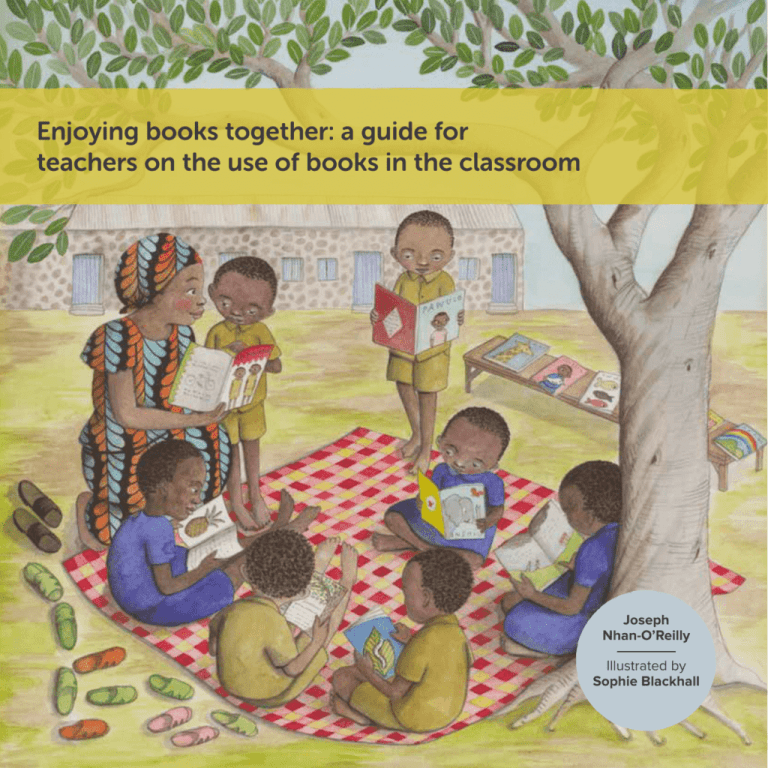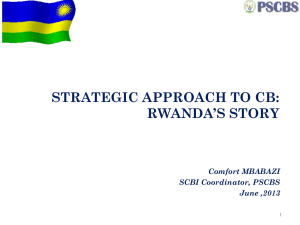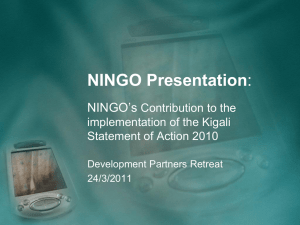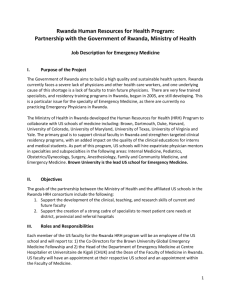Enjoying books together: a guide for teachers on
advertisement

Enjoying books together: a guide for teachers on the use of books in the classroom Joseph Nhan-O’Reilly Illustrated by Sophie Blackhall About this guide This guide has been produced by the Rwandan Children’s Book Initiative, a project of Save the Children. The aim of the guide is to introduce Rwandan teachers to the importance of written material and books and to share some ideas for how they can be used in the classroom to improve student’s learning. ‘Using books in the classroom’ begins with suggestions about how teachers and students can increase the amount of written material in their classrooms. It then looks at books in particular, with the aim of helping teachers understand the types of books available and to begin thinking about what makes a good book for children. Contents The guide then goes on to look in some detail at two approaches for using written material with students in the classroom: The importance of reading 4 The classroom environment 6 • teacher read alouds Books for children 9 • independent reading. Using books in the classroom 10 The introductions to both of these approaches have been designed to encourage teachers to think about new ways in which books can be used, to test these out with their students and to discuss these approaches with their fellow teachers. Teacher read alouds 13 Independent reading 21 Managing your book collection 26 Organising and displaying your books 29 Caring for books 30 Getting Rwanda reading 32 The Rwandan Children’s Book Initiative 34 Finally, the guide includes some suggestions for how to manage a classroom book collection, including organising, displaying and caring for books. This guide will be provided to all teachers who participate in the Rwandan Children’s Book Initiative’s teacher training sessions, but it can also be used on its own. Acknowledgements35 We hope you find it useful! ‘Using books in the classroom’ is also available in Kinyarwanda. Copies can be ordered by emailing rwanda-cbi@savethechildren.org or phoning +250 252 572921 3 The importance of reading Being able to read is a valuable skill. People who can read have access to printed information available in books, newspapers, magazines and on the internet. For children at school being able to read is essential. Children who fail to read in the early grades fall further behind each school year, because reading ability is progressively used as a tool for acquiring other types of knowledge. Learning to read is essential in order to read to learn. As a teacher, helping your students to read will make a lasting positive difference to their time at school and more generally to their lives. 5 The classroom environment Exposure to written and printed texts is essential for developing the ability to read. • Displaying your students’ work on the walls of your classroom creates an interesting teaching environment and shows your students that you value their writing. But in many African countries, communities in general and schools in particular experience a lack of books and other printed material. • Show your students different kinds of reading material. For example you could hold up a letter that you have received from a friend or even an official document or government announcement. Teachers have an important role to play in improving their students’ access to written material. You can make your classroom a rich literate environment in which lots of printed words are on display and where print material is available to students. Here are some ideas: • P roduce your own word cards which you can use to label the items in your classroom, such as the chairs and desks. • D evelop reading cards which might have a simple drawing and the word for the object depicted underneath it. • P roduce your own posters and charts and display these on the walls of your classroom. Point to them as you tell your students what they say. • Show them a book that you have read and tell them about it and why you enjoyed it. • Finally, create a reading corner which contains your classroom book collection, however small, along with items like your reading cards. Having a dedicated space for your books and reading can help make reading a natural and enjoyable part of classroom life. Take time to produce and display written material. Doing this will make your classroom more interesting and make an important contribution to improving your students’ exposure to print, which will improve their learning. 7 Books for children Knowing what a book is and how to use it, including how to hold it and how to turn its pages are part of the skills that make a person literate. This is not the place to store text books, your classroom library should focus on books that are read for pleasure. Giving young children access to books is therefore critical to supporting their ability to read. All books used in Rwandan classrooms must be approved by the Rwandan Education Board. REB approves books for use in a range of years (1 – 3 and 4 – 6) which should help ensure that the books you have in your classroom are appropriate for both the age and reading level of your students. Schools have an important role to play in ensuring children get to see and share books. To ensure this happens, every classroom should have a collection of books that children can use. You do not need a large number of books to create a great book collection. A few well chosen books, especially in the early years of primary school, can introduce children to the importance and magic of reading. Types of books It would be good to include in your collection fiction, non-fiction and picture books so that children understand that there are different types of books. Approved books Exposure to books is the beginning of literacy The most important thing to remember is that children need to see and use books to build the skills and knowledge that will make them effective readers. As a teacher you can play an important role in supporting your students’ reading and learning by ensuring that they have access to books in the school classroom and that using books, both alone and together as a class happens every day. 9 Using books in the classroom There are a variety of simple and very effective ways of using books in the classroom which will support your students as they learn to read. This guide will introduce you to two important and very useful approaches, namely teacher read alouds and independent reading. Teacher read alouds are when a teacher reads a book to the class or a group of students. Independent reading on the other hand involves encouraging students to choose to read, selecting what they want to read and then being able to share what they have read. Varying your teaching methods will help to sustain the enthusiasm and engagement of your students. You can use these approaches each day and not just when dealing with ‘teaching reading’ but when you have written material to use for any subject. Once you’ve read about these approaches, you might like to talk to your fellow teachers about them, asking if they’ve used them and how they found the experience. But most importantly we hope you will try these approaches out yourself and that they become a useful part of your teaching methods. These approaches will help you to meet the diverse needs of your students and ensure that the way in which books and other written materials are used is varied and interesting. 11 Teacher read alouds Teacher read alouds are when you read a book to the class or a group of students. When using this technique you read the book aloud so that each student, regardless of their ability, is engaged and is able to enjoy the words and story. The inclusive nature of a teacher led read aloud session and the fact that it’s done together often makes it the activity within the school day that children most look forward to, especially in the early years. 13 The teacher read aloud session 1. Introducing the book There are four parts to a successful read aloud session: 1. Introducing the book 2. Reading the book 3. Talking about what you are reading 4. Reflecting on the session A read aloud session can last up to 30 minutes each day, but with younger students might be as short as 10 mins. Before you start you need to make sure that all your students can see the book and its writing clearly. Introducing the book is done with the aim of helping your students prepare for the story. Your introduction should be brief and should include identifying the title, author and illustrator. You can then discuss the cover illustration, asking the students what they think the story might be about using the cover illustration as a clue. This is where ‘big books’ are useful. You can encourage them by asking them, “and then what happens?” However if you don’t have access to big books then you might use a normal size book with a smaller group of your students so that all of the students can see the words and pictures. You can also ask your students to tell you their own story based on the cover illustration. You can vary the books you use for your read aloud sessions, choosing a different book each time or reading the same book a number of times. If the story is good children will love returning to the same book and becoming increasingly familiar with the book’s words and sequence of events. 15 2. Reading the book Once you’ve finished the introduction you can begin reading the book. With younger students you can use a pointer or your finger to point to each word as it is read. This will help them concentrate on the words and match the written words with how they sound when read. With older students it is not necessary to point to every word. However, you can point to draw attention to words, information and pictures to help your students understand the significance of these things. Using pictures to encourage your students to predict words and meanings is a particularly useful thing to do when sharing a book in this way. 3. Talk about what you’re reading Whilst reading the book, you should stop occasionally to discuss what you’re reading. You can ask your students questions that draw on the story. They can include questions about what’s already been read such as, “Why do you think the character did that?” or “How do you think the character feels?” A wonderful way of encouraging children to talk about a book that’s just been shared, is to ask them to discuss the book in small groups of up to six students, answering questions like what they most enjoyed about the book. You can also try to relate the book to the children’s own experience. For example, if a story is about a bicycle, you can ask children, “Do you like bicycles?” and “Do you know anyone who owns a bicycle?” You can also ask your students to predict what will happen next, with questions such as “What do you think she’s going to do now?” This shouldn’t detract from the reading of the book, but should be used to complement and enrich the reading. The aim is always to help children make sense of the text. You should also discuss the book after you’ve finished reading it. This might involve asking your students what they thought of the book, whether they liked it, and who their favourite character was. 17 4. Reflecting on the session Once the session has finished it is important for you to reflect on how it went and to consider how your students interacted with the text. You might want to write your reflections in your lesson planning log book. If you are teaching younger children you can note their growing understanding of how printed words work, observing who among your students is focussing on the text, who is quick to join in with the reading and who asks questions about the text. If you are teaching older children you can use your read aloud session to gather useful information about your students’ comprehension, vocabulary and their ability to distinguish between different types of books. You should use your reflections to think about how to conduct the next session. 19 Independent reading Independent reading involves supporting your students by setting aside time for them to read on their own, allowing your students to select what they want to read and then encouraging them to talk about what they have read. There are four aspects to supporting your students to read independently. These are: 1. Choosing reading material 2. Creating space and time for reading 3. Responding to what’s been read 4. Developing a reading culture 21 1. Choosing reading material As their teacher you have an important role in providing books for your students and doing whatever you can to expose them to the variety of reading material available. The books in your classroom book collection should reflect a balance between familiar favourites and new material, fiction and nonfiction books and both books that are easy to read and more challenging material for experienced readers. Whatever you have available the idea of independent reading is that your students get a chance to select what they want to read on their own. To help your students choose from the widest selection of books available you might like to place each of the books available on a mat, so that the cover of every book in your collection can be seen by your students. Seeing the cover illustrations in this way, rather than just the spines, often encourages children to look at a book that they might not otherwise consider. You can help your students choose what they would like to read by encouraging them to think about what the book they are looking at might be about, to think about what they might like about the book and even to begin reading it to see if it is at the correct reading level for their ability. 2. Creating space and time for reading Your students should have opportunities to read independently every day. You can support this by putting aside time in the school day for independent reading, beginning with five or ten minutes and gradually increasing the amount of time. Older students who have more experience reading should be able to read on their own for longer periods. You can make independent reading more enjoyable by making it a special part of your students’ day. You might choose to do this by allowing your students to take their book outside and read under the shade of a tree, or to sit on mats in a corner of your classroom, rather than at their desks. 23 3. Responding to what’s been read 4. Developing a reading culture If your students are to enjoy and understand the books they’ve read they need to have opportunities to talk and write about them. You have an important part to play in supporting your students’ ability to read and instilling in them an appreciation for reading. Talking in small groups of between four and six students about a story, picture book, article or novel is a valuable way for students to understand what they’ve read. You can do this by: Towards the end of an independent reading session, where children have already been given the opportunity to select a book and then start reading it, you might ask the children to form pairs and share the book they’ve been reading with their partner, telling their partner what the book is about and whether they liked it or not and why. • M aking a schedule of the times when independent reading can be fitted in at home. In this way, your students will learn how to talk about and respond to the books they have read. Above all, teachers who love books and reading will find it easy to create a community of readers within the classroom. You can help by encouraging your students to talk about the books they are reading and to ask questions or seek clarification about words and ideas they don’t understand. Encouraging your students to respond to what’s been read can happen in lots of ways. You might also ask your students to draw a favorite scene from the book they’ve just read, to write a short summary of what they’ve read or to make a presentation to the whole class on their favourite part of the book. • Encouraging your students to always carry a book with them to read during any spare time they have. • Inviting your students to talk about a book that they are reading with their parents or carer and reporting back on the discussion at school the next day. By doing this you will see students reading to and with each other, helping less able students and generally enjoying the opportunities that books provide. 25 Managing your book collection Once you begin to develop a collection of books, you and your school need to decide how to store them. The difference is that textbooks are a curriculum-specific book, where all children follow the same book in the class, whereas non-textbook materials are more varied, and can include picture books, stories or readers, general non-fiction, and reference books. There are various ways in which you can choose to store your books. Textbooks may need to be managed in quite different ways to books that aren’t textbooks. However and wherever you store your books the most important thing is to ensure that your students have easy access to them. Because we’re trying to ensure children have as much exposure to books as possible the recommendations that follow are for storing and displaying your books in your classroom rather than anywhere else in your school. Books are a valuable resource and need to be managed and cared for. The easiest and most effective way to help ensure this is to store your books in the classroom. Storing books elsewhere, like in an office or staff room, means it will be more difficult for your students to get to and use the books. Remember, the advice and suggestions in this book refer to books that are not textbooks. 27 Organising and displaying your books Keeping your book collection in your classroom has lots of advantages: • Y ou can ensure the books in your collection are appropriate for the age and ability of the students in your class. • You can be involved in all aspects of establishing and looking after the books. This often helps ensure you feel ownership for and understand the contents of your collection. • B ooks are easily available to you and your students to supplement your lessons and encourage reading at every opportunity. Bookshelves Some schools will have received classroom bookshelves from the Rwandan Children’s Book Initiative. These shelves have been designed to provide a simple, accessible way of storing and displaying your books. The shelves can also be locked for security. Displaying some of your books with their covers facing your students is an excellent way of increasing their exposure to books. Organising your books The best way to start organising your collection is to split the books into fiction and non-fiction. Your story books can be organised into appropriate categories such as ‘animals’, ‘adventure’ and ‘fantasy’. It might also be worth organising your book collection according to grade or reading level, with easier books clearly grouped together. If you have English books in addition to books in Kinyarwanda keep them separate. Keep the system simple and remember make your book collection accessible, attractive and fun and do everything you can to encourage your students to browse the collection of books often. The shelves allow you to choose a selection of books and to display them, either on the doors of the shelves or on the top. 29 Caring for your books Books are a fantastic but expensive resource and need to be looked after carefully. If you do the following things your book collection will remain in good order for longer: • D ust the shelves regularly so that the books stay clean. • Wipe the covers of the books too. • K eep the shelves and books away from any damp or wet areas so that the books stay dry. Think about this when you decide on where to put your bookshelves. • E nsure that before a session which involves using the books that your students have clean, dry hands. You might want to take everyone to wash their hands before an independent reading session. Washing hands is good for children’s health too, so practicing and encouraging hand washing is a good thing. • Teach students and other teachers not to break the spine of books and to handle them carefully. • If the cover or the spine a book is damaged, repair it straight away. • Your school should have a store of tape, glue and cardboard, for use when books have been damaged. • If a book has been badly damaged and is unreadable, it should be removed from the shelf. Even though we want to ensure that books are looked after properly, this doesn’t mean we don’t want children handling them – we do! Clean books on shelves that haven’t been handled and read haven’t served their purpose. 31 Getting Rwanda reading Reading opens up our understanding of the world. Through reading we can find out what’s happening in our local community or discover a community in a faraway land. Reading also gives us the power to discover what others have written thousands of years ago and to understand the technology and processes that are shaping our future. Reading has the power to change our lives. Improving early grade reading and promoting reading is a priority of the Government of Rwanda in general and for the Rwandan Education Board in particular. The Rwandan Children’s Book Initiative is pleased to support the Rwandan Government’s ambitions to get Rwanda reading. As a teacher you have a critical role to play in helping transform your students’ lives, including by helping your students to read. We hope you’ll be inspired by this simple guide to produce more written material for and with your students and to use the books that are available in your school and classroom to support your students to acquire and develop their reading skills. We have also produced a simple companion booklet which aims to support parents and carers to promote literacy at home. Both guides are also available in Kinyarwanda. 33 The Rwandan Children’s Book Initiative The vision of the Rwandan Children’s Book Initiative is more children reading more and better books. We recognise that achieving that vision requires action at a variety of levels in support of a dynamic literate environment, including improving the availability, appropriateness, accessibility and use of books. As part of our efforts to increase the availability of high quality, age appropriate local language children’s books we work to support improvements in the knowledge, skills and capacity of the Rwandan book sector, including authors, illustrators, designers and publishers to produce better children’s books. We then purchase books from local publishers that meet our standards and then distribute those books to schools and communities. Acknowledgements Teachers and principals from our partner schools receive training and support in book management and use. Parents in communities in which we are working receive support and encouragement for using books with their children. We are also committed to supporting national and local policies that will help deliver a richer literate environment. The Rwandan Children’s Book Initiative is part of a growing global network of national Children’s Book Initiatives that are being established by Save the Children. This guide was written by Joseph Nhan-O’Reilly with the assistance of Richard Germond and Sofia Cozzolino. Produced by RWANDAN The illustrations throughout the guide are by world renowned illustrator Sophie Blackall. www.sophieblackall.com A project of The guide was designed by Creative Coop. www.creative.coop The teacher training programme associated with this guide was developed in partnership with representatives of the Rwandan Education Board, district education officers, principals, teachers and a range of other education sector colleagues during the course of 2013. We are extremely grateful for their cooperation and assistance. The Rwandan Children’s Book Initiative is supported by Innovation for Education, a partnership between the Governments of Rwanda and the UK. In partnership with Funded by © Save the Children, 2014 35 ‘Enjoying books together’ has been produced by the Rwandan Children’s Book Initiative. This guide introduces teachers to the importance of written material and books and provides ideas on how books and other printed material can be used in the classroom to improve student learning. Our vision is more children reading more and better books. We hope this guide helps you make that vision a reality for the children in your class. RWANDAN





